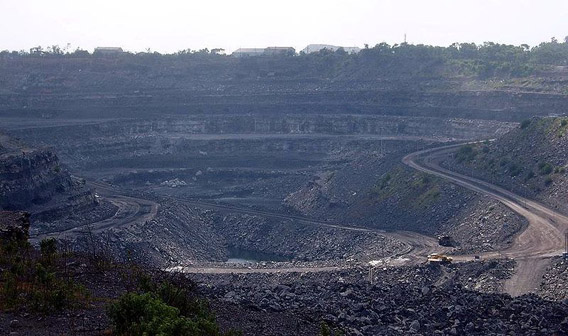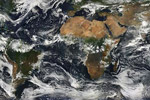
Surface coal mining in Bihar, India. Around 40 percent of India’s power is currently provided by coal, the most carbon intensive fuel source.
Last year global carbon dioxide emissions rose 3.2 percent to a new record of 31.6 gigatons, keeping the planet on track to suffer dangerous climate change, which could propel global crop failures, sea level rise, worsening extreme weather, and mass extinction. According to data from the International Energy Agency (IEA), China’s carbon emissions rose the most last year (9.3 percent) while emissions in Europe and the U.S. dipped slightly. China is the currently the world’s largest emitter of greenhouse gases, while the U.S. has emitted the most historically.
“When I look at this data, the trend is perfectly in line with a temperature increase of 6 degrees Celsius [11 degrees Fahrenheit], which would have devastating consequences for the planet,” Fatih Birol, economist with the IEA, told Reuters.
China’s massive growth in emissions last year was linked to higher coal consumption in the economically booming nation. In addition to China, India also saw a similar spike of 8.7 percent in its carbon dioxide emissions, pushing the nation to become the world fourth largest carbon emitter after China, the U.S. and the EU. Russia dropped to number five. Japan’s emissions increased 2.4 percent due to greater reliance on fossil fuel power after the nuclear disaster at Fukushima.
Both the U.S. and the EU saw slight declines in their emissions. U.S. carbon emissions dropped 1.7 percent due to a rise in natural gas over coal energy, a decline in oil use, and a warm winter, which reduced heating demands. The EU saw a drop of 1.9 percent due to slow economic growth and, like the U.S., a mild winter.
Even as China’s emissions continue to rise, the IEA points out that the nation has cut its carbon intensity (carbon emissions linked to GDP) by 15 percent since 2005. China recently announced it was investing $27 billion in renewable energies, energy conservation, and emissions reduction in 2012.
Still, nations worldwide are not doing near-enough to keep their pledge of not allowing global temperatures to rise 2 degrees Celsius (3.6 degrees Fahrenheit) above the 20th Century average warns the IEA.
“The new data provide further evidence that the door to a 2 degrees Celsius trajectory is about to close,” warned Birol in a press release.
Nearly half (45 percent) of the emissions reported by the IEA were linked to coal, 35 percent to oil, and 20 percent to natural gas.
Even as the IEA’s new data was released nations were finishing up another round of international climate talks in Bonn, Germany. However, these talks appeared to be the most acrimonious yet with discussion largely stalemated on procedural issues.
“It’s absurd to watch governments sit and point fingers and fight like little kids while the scientists explain about the terrifying impacts of climate change and the fact that we have all the technology we need to solve the problem while creating new green jobs,” Tove Maria Ryding, coordinator for climate policy at Greenpeace International, said in a statement.
Temperatures around the world from 1880 to 2011 by NASA as compared to the 20th Century average.
Related articles
Groups urge President Obama to attend Rio+20 Sustainability Summit
(05/22/2012) Twenty-two conservation, indigenous, health and science groups have called on U.S. President Barack Obama to attend the up-coming Rio+20 Summit on Sustainable Development.
Featured video: why one scientist is getting arrested over climate change
(05/16/2012) In March 2012 the head of NASA’s Goddard Institute for Space Studies and well-known climatologist, James Hansen, spoke at a TED conference to explain what would push a 70-year-old scientist to participate in civil disobedience against mountaintop coal mining and the Keystone Pipeline, even leading to several arrests.
Consumption, population, and declining Earth: wake-up call for Rio+20

(05/15/2012) Currently, human society is consuming natural resources as if there were one-and-a-half Earths, and not just a single blue planet, according to the most recent Living Planet Report released today. If governments and societies continue with ‘business-as-usual’ practices, we could be consuming three years of natural resources in 12 months by 2050. Already, this ecological debt is decimating wildlife populations worldwide, disproportionately hurting the world’s poor and most vulnerable, threatening imperative resources like food and water, heating up the atmosphere, and risking global well-being.
Thousands worldwide to “connect the dots” between climate change and extreme weather this weekend

(05/03/2012) On Saturday, May 5th vulnerable populations from the United States to Bangladesh will “connect the dots” between devastating extreme weather and climate change in a global day of action organized by 350.org. The nearly 1,000 events occurring in over half of the world’s nations are meant to highlight to governments, media, and the public that climate change is impacting lives through an increase in number and intensity of devastating weather events, such as droughts, heatwaves, and floods.
Mexico passes aggressive climate bill

(04/23/2012) Last week, Mexico’s Senate passed an aggressive and comprehensive climate change bill, making it the first developing nation and only the second country to do so, after the UK. The bill, which far outshines anything achieved by its far wealthier northern neighbors, sets ambitious targets for cutting emissions while creating new incentive programs for clean energy. Largely dependent on fossil fuels, Mexico is approximately the 11th highest greenhouse gas emitter in the world.
For Earth Day, 17 celebrated scientists on how to make a better world

(04/22/2012) Seventeen top scientists and four acclaimed conservation organizations have called for radical action to create a better world for this and future generations. Compiled by 21 past winners of the prestigious Blue Planet Prize, a new paper recommends solutions for some of the world’s most pressing problems including climate change, poverty, and mass extinction. The paper, entitled Environment and Development Challenges: The Imperative to Act, was recently presented at the UN Environment Program governing council meeting in Nairobi, Kenya.
Oceans heating up for over 100 years
(04/02/2012) In 1872 the HMS Challenger pulled out from Portsmouth, England to begin an unprecedented scientific expedition of the world’s oceans. During its over three year journey the HMS Challenger not only collected thousands of new species and sounded unknown ocean depths, but also took hundreds of temperature readings—data which is now proving invaluable to our understanding of climate change.
“Strong evidence” linking extreme heatwaves, floods, and droughts to climate change
(03/28/2012) As North America recovers from what noted meteorologist Jeff Masters has called “the most incredible spring heatwave in U.S. and Canadian recorded history,” a new paper argues that climate change is playing an important role in a world that appears increasingly pummeled by extreme weather. Published in Nature Climate Change, the paper surveys recent studies of climate change and extreme weather and finds “strong evidence” of a link between a warming world and the frequency and intensity of droughts, floods, and heatwaves—such as the one that turned winter into summer in the U.S.
NASA image shows decline in maximum sea ice extent
(03/28/2012) Data released by the National Snow and Ice Data Center (NSIDC) shows that Arctic sea ice for the winter of 2011-2012 reached its maximum extent on March 18 at 15.24 million square kilometers (5.88 million square miles). The mark is well below the 1979–2000 average, but was above the record low of the 2010–2011 winter.
Birders beware: climate change could push 600 tropical birds into extinction

(02/21/2012) There may be less birds for birders to see in the world as the planet warms. Climate change, in combination with deforestation, could send between 100 and 2,500 tropical birds to extinction before the end of century, according to new research published in Biological Conservation. The wide range depends on the extent of climate and how much habitat is lost, but researchers say the most likely range of extinctions is between 600 and 900 species, meaning about 10-14 percent of tropical birds, excluding migratory species.
Six nations, including U.S., set up climate initiative to target short-term greenhouse gases
(02/20/2012) With global negotiations to tackle carbon emissions progressing interminably, nations are seeking roundabout ways to combat global climate change. U.S. Secretary of State, Hillary Clinton, announced in India last week a new six nation initiative to target non-carbon greenhouse gases, including soot (also known as “black carbon”), methane, and hydro-fluorocarbons (HFCs). Reductions of these emissions would not only impact short-term climate change, but also improve health and agriculture worldwide according to a recent study in Science.














